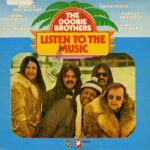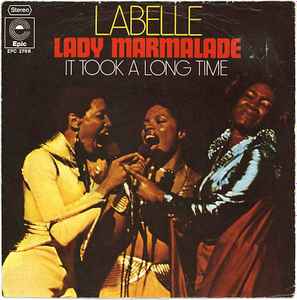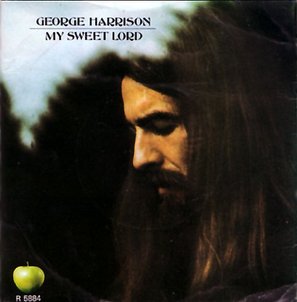 The Doobie Brothers’ “Listen to the Music,” released in 1972 on their self-titled second album, stands as one of the most iconic tracks in the history of American rock. Written by founding member Tom Johnston, the song is a masterclass in the fusion of upbeat rock, infectious melody, and thoughtful lyricism. With its joyful rhythm, layered harmonies, and irresistible guitar riffs, “Listen to the Music” embodies a timeless sense of optimism and unity, making it a track that transcends generations. It’s more than just a song; it’s an invitation to feel, celebrate, and connect through the universal language of music.
The Doobie Brothers’ “Listen to the Music,” released in 1972 on their self-titled second album, stands as one of the most iconic tracks in the history of American rock. Written by founding member Tom Johnston, the song is a masterclass in the fusion of upbeat rock, infectious melody, and thoughtful lyricism. With its joyful rhythm, layered harmonies, and irresistible guitar riffs, “Listen to the Music” embodies a timeless sense of optimism and unity, making it a track that transcends generations. It’s more than just a song; it’s an invitation to feel, celebrate, and connect through the universal language of music.
From the opening guitar riff, “Listen to the Music” immediately signals its intent. The bright, chiming guitar chords are buoyant and energetic, creating a warm, sunlit sonic landscape. Johnston’s guitar work is simultaneously intricate and accessible, combining rhythmic strumming with melodic fills that capture the listener’s attention. The riff functions as both a musical hook and a thematic introduction, echoing the song’s central idea: the simple yet profound power of music to uplift the spirit and bring people together.
Lyrics as a Call to Joy
At the heart of “Listen to the Music” is its lyrical message. Johnston wrote the song during a period of social unrest in the United States, seeking to craft a track that could serve as a unifying force. Lines such as “Listen to the music / All the time, people” convey a sense of communal celebration and emotional release. The lyrics are straightforward yet potent, emphasizing the universal ability of music to transcend barriers and foster connection.
The song’s verses balance optimism with reflection. Johnston acknowledges the difficulties of life — societal pressures, personal struggles, and the complexities of the human experience — but contrasts these challenges with the transformative power of music. The act of listening, of immersing oneself in sound, becomes a form of liberation. The simplicity of the phrasing contributes to the track’s timeless appeal, allowing listeners of all backgrounds to relate to its message.
The chorus, repeated with joyous insistence, is particularly effective. It functions almost as a mantra, encouraging listeners to embrace positivity, tune into the rhythms of life, and find solace in melody. The repetition is not monotonous; rather, it reinforces the communal spirit of the song, turning it into an anthem of celebration and togetherness.
Vocal Performance and Harmonies
Tom Johnston’s lead vocals carry the song with warmth, clarity, and conviction. His voice is approachable and emotive, striking a balance between relaxed sincerity and expressive energy. Johnston’s phrasing conveys both joy and earnestness, perfectly aligning with the song’s thematic focus on the power of music to inspire and heal.
The harmonies provided by Michael McDonald and other band members elevate the song to another level. The layered vocals are lush and dynamic, weaving in and out of the lead line with precision and artistry. These harmonies reinforce the sense of unity central to the track’s message, as if the band itself is modeling the communal experience it seeks to inspire in the listener. The vocal interplay creates a rich, textured sound that is both pleasing and emotionally resonant, adding depth to the otherwise straightforward lyrical content.
Instrumentation: Crafting a Feel-Good Sound
The instrumentation on “Listen to the Music” is a testament to the Doobie Brothers’ skill and attention to detail. Beyond the sparkling guitar work, the rhythm section — led by Tiran Porter on bass and John Hartman on drums — provides a steady, infectious groove that anchors the song. The drums maintain a precise yet relaxed tempo, allowing the guitars and vocals to shine without overwhelming the mix. The bassline is melodic, complementing the harmonic structure while adding its own rhythmic momentum.
Additional layers, including congas and subtle keyboard textures, contribute to the song’s rich sonic tapestry. These elements enhance the track’s warmth and create a sense of movement and life, reflecting the vibrancy of its lyrical themes. The arrangement is carefully balanced, ensuring that each component serves the song’s overall emotional and musical goals without overcrowding the sonic space.
The guitar solo, understated yet memorable, exemplifies the band’s ability to fuse technical skill with melodic sensibility. Rather than dominating the track, it complements the vocals and harmonies, providing a moment of musical reflection that reinforces the song’s celebratory mood. This restraint is a hallmark of the Doobie Brothers’ approach, demonstrating that virtuosity is most effective when it serves the song rather than overshadows it.
Production Excellence
“Listen to the Music” benefits from meticulous production by Ted Templeman, who had a deep understanding of the band’s strengths and sonic identity. The mix is clear and spacious, allowing each instrument to occupy its own space while contributing to a cohesive whole. The guitars, vocals, bass, and percussion are perfectly balanced, ensuring that the song maintains both energy and clarity.
Templeman’s production emphasizes the song’s emotional core, highlighting the warmth of the vocals and the bright, shimmering quality of the guitar lines. Reverb and subtle effects are used sparingly but effectively, creating an expansive, open sound that mirrors the thematic emphasis on communal joy and connection. The production ensures that the song’s feel-good energy is felt immediately and sustained throughout its duration.
Cultural Context and Enduring Appeal
Released in the early 1970s, “Listen to the Music” arrived at a moment of cultural transition. The social upheaval of the 1960s had left a mark on the national consciousness, and music continued to serve as a vehicle for both reflection and escape. Amidst political tensions and societal change, the Doobie Brothers offered a message of optimism and unity, packaged in a sound that was both accessible and musically sophisticated.
The song quickly became a hit, reaching the top 20 on the Billboard Hot 100 and securing the Doobie Brothers’ status as one of the premier rock acts of the era. Its appeal has endured through decades, with continued radio play, use in film and television, and frequent cover versions attesting to its universal resonance. The song’s timeless quality lies in its combination of musical craftsmanship, lyrical sincerity, and emotional authenticity.
“Listen to the Music” transcends its era because its message remains universally relevant. The idea that music can unite, uplift, and provide solace is as potent today as it was fifty years ago. In a world often divided by difference and conflict, the song’s invitation to “listen” serves as both a reminder and a rallying cry for connection and shared joy.
Emotional Impact and Listener Experience
At its core, “Listen to the Music” is about emotional experience. The song doesn’t simply entertain; it invites the listener to participate, to immerse themselves in the rhythmic and melodic flow. The combination of uplifting harmonies, driving rhythm, and jubilant guitar work creates an emotional high that feels both personal and communal.
Listeners are drawn into a space of celebration, encouraged to let go of worries and embrace the joyous simplicity of music. This emotional accessibility is part of the song’s genius. It manages to be musically sophisticated while remaining instantly relatable, appealing to both casual listeners and serious music enthusiasts. The experience of listening is holistic — auditory, emotional, and even almost physical, as the song’s rhythm naturally compels movement and engagement.
Song Structure and Dynamics
Structurally, “Listen to the Music” is elegant in its simplicity. It follows a verse-chorus format, but the dynamics and arrangement elevate it beyond a standard pop-rock track. The verses are steady and engaging, building anticipation, while the choruses release that energy with soaring vocal harmonies and expansive instrumentation.
The bridge provides a moment of contrast, with subtle variations in melody and rhythm that prevent monotony and maintain listener interest. This careful attention to pacing and dynamics ensures that the song remains compelling from start to finish. The track’s relatively concise length — just over four minutes — allows it to deliver its emotional and musical impact efficiently, without overstaying its welcome.
Influence and Legacy
“Listen to the Music” has had a profound influence on rock and pop music. Its blend of accessible melody, rich harmonies, and tight instrumentation became a blueprint for countless bands seeking to balance musical sophistication with mass appeal. The song’s optimistic message and celebratory tone also contributed to the broader trend of feel-good rock music in the 1970s, influencing the sound of American radio and live performance.
The Doobie Brothers’ integration of multiple vocalists, layered instrumentation, and dynamic arrangements showcased the potential of rock music as a vehicle for both personal expression and communal experience. This approach has been emulated by numerous artists across genres, from soft rock to modern pop-rock, highlighting the song’s lasting impact.
Conclusion: A Timeless Anthem
“Listen to the Music” remains a quintessential track in the Doobie Brothers’ catalog and a shining example of the power of rock music to inspire joy, reflection, and connection. Its combination of infectious rhythm, rich harmonies, and thoughtful lyricism ensures that it continues to resonate with listeners across generations. The song exemplifies the band’s ability to craft music that is both musically intricate and emotionally immediate, creating an experience that is as rewarding today as it was at its release.
By blending technical proficiency with heartfelt expression, the Doobie Brothers created a track that transcends time. “Listen to the Music” is not just a song; it’s a celebration of life, a reminder of music’s ability to unite people, and an enduring anthem of optimism. Its joyous energy, lyrical sincerity, and instrumental mastery make it a defining moment in American rock history and a testament to the enduring power of melody, rhythm, and human connection.
Whether one encounters the song for the first time or revisits it decades later, the invitation remains clear: to stop, tune in, and let the music carry you. It is this timeless appeal — the ability to evoke emotion, inspire movement, and foster unity — that cements “Listen to the Music” as a true classic of the rock canon.


